2012 Kawasaki Versys Review
Preparing for battle with the V-Strom and G650GS
When Suzuki alluded to the KawasakiVersys as a competitive benchmark for the born-again V-Strom 650, we took note. Not having ridden the Versys since its 2010 makeover, we ordered one up in advance of a comparison test.
Since last reviewing the Versys, its cost has grown $300 from an MSRP of $7,600 in 2010 to $7,900 for 2012. What three more Bens buys you is a new color (a striking Pearl Solar Yellow/Ebony combo) and a bunch of inflation. The 2010 Versys' $500 price bump boasted a host of upgrades including:
* A new fairing, stacked dual headlight, new front fender and mirrors, and an LED tail light
* A larger windscreen with three-position adjustability
* Revised passenger grab rails, new seat cover material, and revised passenger seating position
* Rubber bushings at the rear engine mounts and hollow rubber-covered footpegs
* Revisions to the muffler, clutch cover, sprocket and alternator covers, radiator shrouds, swingarm pivot covers and rear fender
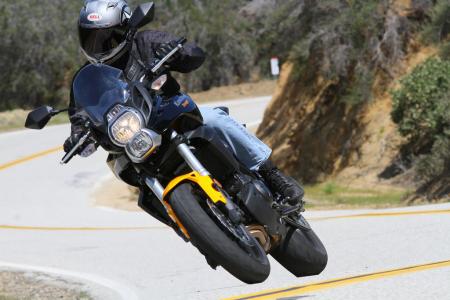 The Versys won't be pigeonholed, but it's more sportbike than off-roader. |
The Versys, with its longish (5.9 in. front and 5.7 in. rear) suspension travel and tall 33.3-in. seat height, conveys a certain degree of off-road capability, but its 17-inch cast aluminum wheels and Dunlop Sportmax tires speak to its true nature. Sure, a person can modify the Versys to be more capable of off-road work, but more suitable bikes exist. Our forthcoming shootout will examine the relative merits of each manufacturer's approach to achieving a useful street/dirt balance.
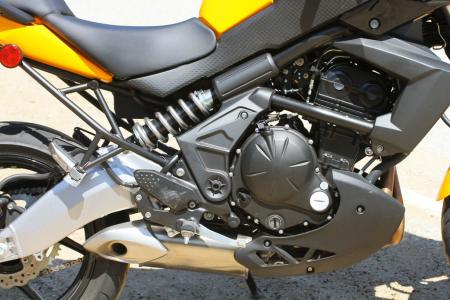
In the street/dirt balance equation, the Versys leans heavily toward the street and is a strong performer in the twisties. But its under-engine exhaust and 17-inch tires aren't conducive to aggressive off-road riding.
As an urban-assault cycle, the Versys excels. Its snappy, 649cc parallel-Twin engine jettisons away from stoplights and makes short work of navigating heavy city traffic. The large passenger grab handle doubles as an effective appendage for securing items when in-transit, while the Versys' mirrors provide an unobstructed view of dangers approaching from behind.
Beyond city limits the Versys is a great weapon for attacking gnarled switchbacks and embarrassing sportbike pilots tiptoeing across chunked asphalt. Or, attach Kawasaki's available hardbags and head out for a tour of the contiguous 48. The Versys' neutral seating position provides a balanced combination of comfort and control, and its three-way adjustable windscreen deflects more or less wind depending on the situation.
The result of trying to keep a fairly low seat height is a short distance from footpegs to seat that cramps taller riders and is exacerbated by a concave section at the rear of the seat where tall riders sit. Our shorter testers weren't bothered, but tall riders are faced with increasing discomfort as the miles accumulate - those above six feet might want to look at aftermarket alternatives.
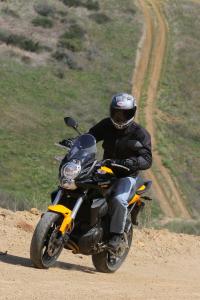 Long-travel suspension and 17-inch wheels send a mixed message, but the Versys will handily navigate the common fire road. More aggressive off-roading will require more enduroesque tires. | 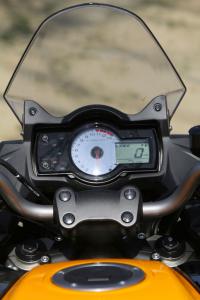 No frills here, but the gauge cluster is clean and legible. Dual tripmeters are a nice touch, as is the adjustable windscreen that shelters riders of various sizes. |
Kawasaki endowed the Versys with rebound and preload damping adjustability to both the 41mm inverted front fork and lay-down rear shock. The instrument cluster, while spartan, includes a fuel gauge, clock and dual tripmeters. Adjustable clutch and front brake levers ably fit a variety of hands.
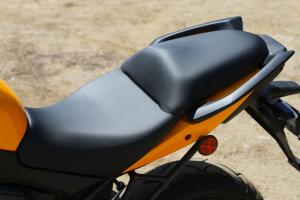
After 200 miles, tall riders will grow to heavily dislike this saddle. Roderick describes it as a thinly disguised torture device, but our shorter testers judged it as satisfactory.
At approximately 490 lbs with its 5.0-gallon tank full, the Versys is kind of hefty for a mid-displacement Twin producing 56.5 hp at 8250 rpm, but its linear powerband is a willing accomplice in most any situation short of long, open roads or a racetrack. Fuel mileage in our hands was in the low-to-mid 40-mpg margin, so the Versys has an admirable range of more than 200 miles. Its 6-speed transmission was less impressive, exhibiting a clunky response to our toes.
Consensus in our 2010 review of the Versys was "if faced with a budget for only one mid-size street bike, a lot of riders - old, young or in between - might want to take a closer look at the Versys."
What we'll soon discover is how the Versys stacks up against two equivalent, yet more dirt-worthy adversaries. At $8,300 - including ABS - the Suzuki V-Strom is marginally more expensive than the Versys, but is the 645cc, V-Twin-powered Strom a better all-around bike? Same goes for the $7,850 BMW G650GS, which also incorporates ABS but is powered by a relatively meek 652cc Single.
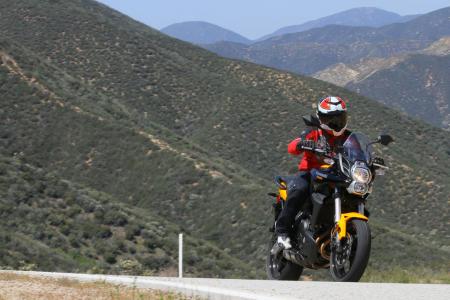 |















0 comments:
Post a Comment